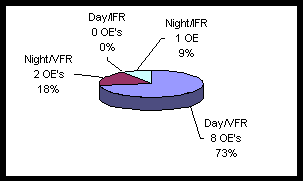Reducing Operational Errors Related to Runway Incursions
/*T/ In recent months, there has been a significant increase in operational errors (OE) that resulted in runway incursions. In March 2000 alone, there were 11 errors that resulted in a runway incursion compared to three in March 1999. One of those 11 runway incursions resulted in an accident with fatalities. This was the first runway incursion accident since 1994.
Of the 11 March 2000 OE's, only three occurred at night, and only one occurred in IFR conditions. The chart below shows that 73 percent occurred during daytime hours with VFR conditions.
The paragraphs following the chart contain brief synopses of some of the recent operational errors.

Operational Errors for March 2000
Deficiency - Scanning
Deficiency – Scanning
Flight progress strip scanning
Deficiency – Scanning
Flight progress strip scanning
Deficiency – Position determination, scanning.
Did not get verification from the pilot that the aircraft was clear of the runway and failed to use the aid of the ASDE.
Deficiency – Scanning
Runway incursions caused by operational errors can be prevented, even eliminated, by getting back to the basics:
Scan effectively.
Use the memory aids provided. Many times memory aids are provided but are not used. The same applies to flight strip management. Follow the facility's ritual of strip management. Train yourself to use memory aids and strip management, not because they are mandated, but because they ensure the safety of the operation. Remember that complacency can lead to errors.
REVIEW THE FOLLOWING 7110.65 PARAGRAPHS:
2-10-3 TOWER TEAM POSITION RESPONSIBILITIES
a. 1. There are no absolute divisions of responsibilities regarding position operations. The tasks to be completed remain the same whether one, two, or three people are working positions within a tower cab. The team as a whole has responsibility for the safe and efficient operation of that tower cab.
3-1-12 VISUALLY SCANNING RUNWAYS
Local controllers shall visually scan runways to the maximum extent possible.
b. Ground control shall assist local control in visually scanning runways, especially when runways are in close proximity to other movement areas.
3-1-4. COORDINATION BETWEEN LOCAL AND GROUND CONTROLLERS
Local and ground controllers shall exchange information as necessary for the safe and efficient use of airport runways and movement areas. This may be accomplished via verbal means, flight progress strips, other written information, or automation displays. As a minimum, provide aircraft identification and applicable runway/intersection/taxiway information as follows:
a. Ground control shall notify local control when a departing aircraft has been taxied to a runway other than one previously designated as active.
b. Ground control shall notify local control of any aircraft taxied to an intersection for takeoff, unless departure from that intersection is specifically designated via prior coordination or facility directive as the standard operating procedure for the runway to be used. When standard procedures require departures to use a specific intersection, ground control shall notify local control when aircraft are taxied to other portions of the runway for departure.
c. When the runways in use for landing/departing aircraft are not visible from the tower or the aircraft using them are not visible on radar, advise the local/ground controller of the aircraft's location before releasing the aircraft to the other controller.
3-1-5. VEHICLES/EQUIPMENT/ PERSONNEL ON RUNWAYS
a. Ensure that the runway to be used is free of all known ground vehicles, equipment, and personnel before a departing aircraft starts takeoff or a landing aircraft crosses the runway threshold.
3-1-7. POSITION DETERMINATION
Determine the position of an aircraft before issuing taxi instructions or takeoff clearance.
NOTE- The aircraft's position may be determined visually by the controller, by pilots, or through the use of the ASDE.
(ATP-20)